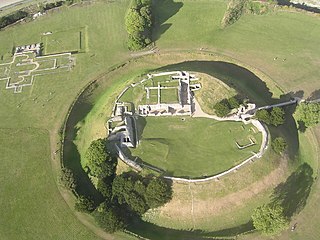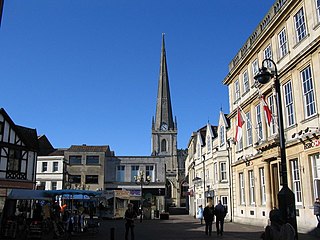 W
WAshton Keynes Castle was in the village of Ashton Keynes, near to the town of Cricklade in Wiltshire, England. It is also known as Hall's Close, while locals call it The Battlefield. The scheduled monument consists of a ringwork and bailey 100 metres (330 ft) west of Kentend Farm.
 W
WCastle Hill, also called Mere Castle, was a medieval fortification built by Richard, the Earl of Cornwall, in 1253 on a hill overlooking the town of Mere, Wiltshire, England. The castle was constructed in stone, with six towers, inner buildings and gates. It was abandoned in the 14th century and stripped of its stone and metalwork. Only earthworks remain in the 21st century.
 W
WClarendon Palace is a medieval ruin 2+1⁄4 miles (3.6 km) east of Salisbury in Wiltshire, England. The palace was a royal residence during the Middle Ages, and was the location of the Assize of Clarendon which developed the Constitutions of Clarendon. It now lies within the grounds of Clarendon Park.
 W
WDevizes Castle was a medieval fortification in the town of Devizes, Wiltshire, England, on a site now occupied by a Victorian-era castle. It is a Grade I listed building. The original castle was overbuilt by the current structure. Records indicate that the first castle on the site had its origins in about 1080 as an early Norman motte and bailey with wooden pallisade and tower.
 W
WLongford Castle stands on the banks of the River Avon south of Salisbury, Wiltshire, England. It is the seat of the Earl of Radnor, and an example of the Elizabethan prodigy house.
 W
WLudgershall Castle is a ruined 12th-century fortified royal residence at Ludgershall in Wiltshire, England. Three large walls still remain of the castle, which was turned into a hunting lodge by Henry III but fell into disuse by the 15th century. The ruin was listed as a Scheduled Ancient Monument in 1981.
 W
WMalmesbury Castle was a castle in the town of Malmesbury, Wiltshire, England.
 W
WMarlborough Castle, locally known and recorded in historical documents as The Mound, was an 11th-century royal castle located in the civil parish of Marlborough, a market town in the English county of Wiltshire, on the Old Bath Road, the old main road from London to Bath. The barrow on which the fortification was built, perhaps the "barrow of Maerla", seems to be a prehistoric earthwork which formed the motte of the Norman Marlborough Castle. It survives as a tree-covered mound known as Marlborough Mound, within the site of Marlborough College.
 W
WOld Sarum Castle, formerly known as Seresberi Castle, is an 11th century motte-and-bailey castle built in Old Sarum, Wiltshire. It was originally built in timber and it was eventually built in stone, of which the ruins can be seen today. Only the mound and foundations of the castle survive today. The castle is owned by the English Heritage and it is open to the public, along with the rest of Old Sarum.
 W
WOld Sarum, in Wiltshire, South West England, is the now ruined and deserted site of the earliest settlement of Salisbury. Situated on a hill about 2 miles (3 km) north of modern Salisbury near the A345 road, the settlement appears in some of the earliest records in the country. It is an English Heritage property and is open to the public.
 W
WTrowbridge Castle was a castle in Trowbridge, Wiltshire. It is thought to have been a motte-and-bailey castle, and its influence can still be seen in the town today. Fore Street follows the path of the castle ditch, and town has a Castle Street and the Castle Place Shopping Centre.
 W
WWardour Castle is a ruined 14th-century castle at Wardour, on the boundaries of Tisbury and Donhead St Andrew in the English county of Wiltshire, about 15 miles (24 km) west of Salisbury. The castle was built in the 1390s, came into the ownership of the Arundells in the 16th century and was rendered uninhabitable in 1643 and 1644 during the English Civil War. A Grade I listed building, it is managed by English Heritage and open to the public.